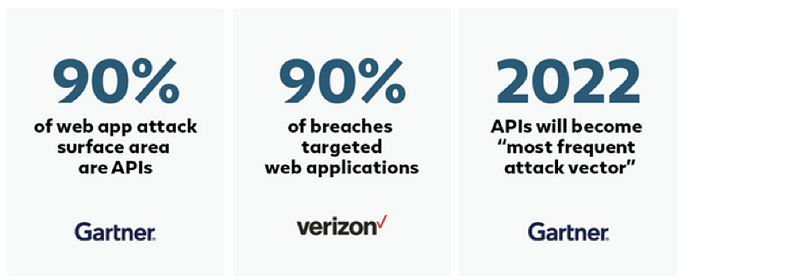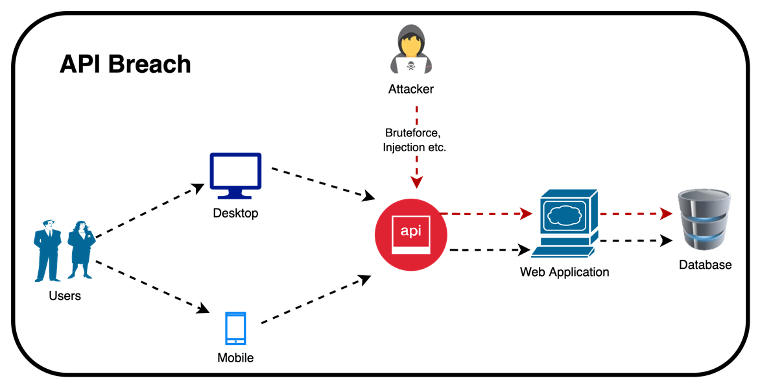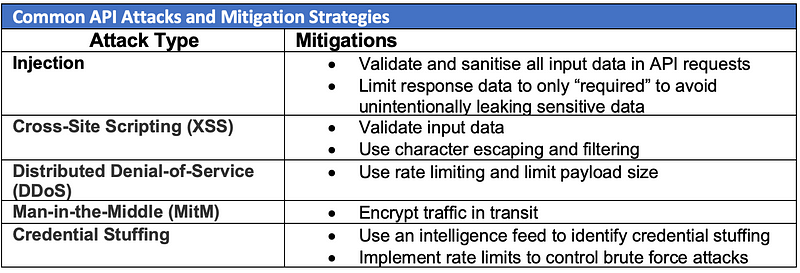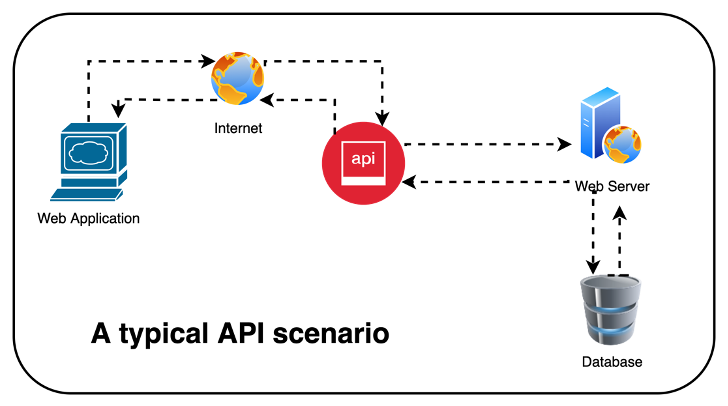Originally published on cyberbakery.net
Globally, businesses leveraged the benefits of transforming their businesses by adopting new ways of doing business and delivering their products to the market quickly and efficiently. The digital transformation has made a distinctive contribution to this effort. Organisations use modern and efficient applications to deliver the above business outcomes. APIs, behind the scenes, are the most critical components that help web and mobile applications deliver innovative products and services.
API is a piece of software that has direct access to the upstream or downstream applications and, in some cases, directly to the data. The following picture depicts a typical scenario where a web application calls an API, which calls downstream resources and data. Unfortunately, due to the nature of the API, direct access to the data introduces a new attack surface called “API Breaches”, which is continuously on the rise, resulting in impersonation, data theft, and financial fraud.
According to Gartner, by 2022, the outlook of API breaches will change from an infrequent breach to the most-frequent attack vector, which will result in frequent data losses for enterprise web applications. This changing trend has brought the realisation that something needs to be done to protect data at the API and the digital interfaces level.

Example of an API Breach
There are many factors of API breaches, and one of the common issues is the broad permissions within the application ecosystem intended for a non-human interaction. Stricter controls regarding user access ensure only the authorised user can access the application. Once a user is authenticated, the APIs can frequently access any data. This is all said and done, but the problem starts when a bad actor bypasses the user authentication accessing the data from the downstream systems.

The above picture shows a user accessing a mobile application using an API while the desktop users connect the same API accessing the same backend through a web interface. Mobile API calls include URIs, methods, headers, and other parameters like a basic web request. Therefore, the API calls are exposed to similar web attacks, such as injection, credential brute force, parameter tampering, and session snooping. Hackers can employ the same tactics that would work against a traditional web application, such as brute force or injection attacks, to breach the mobile API. It is inherently difficult to secure mobile applications. Therefore, attackers are continuously decompiling and reverse engineering mobile applications in pursuit of finding vulnerabilities or opportunities to discover hardcoded credentials or weak access control methods.
API Security Threats
OWASP.ORG, in 2019 released a list of top10 API Security Threats advising on the strategies and solutions to mitigate the unique security challenges and security risks of APIs. Following are the ten API security threats.
API1:2019: Broken Object-Level Authorisation
APIs often expose endpoints handling object identifiers. This exposure leads to a wide attack surface where a user function used to access a data source creates a Level Access Control issue. Therefore, it is recommended to carry out object-level authorisation checks for all such functions accessing data.
API2:2019: Broken User Authentication
User Authentication is the first control gate accessing the application, and attackers often take advantage of the incorrectly applied authentication mechanisms. It is found that the attackers may compromise an authentication token or exploit flaws assume other user’s identity temporarily or permanently. Once compromised, the overall security of the APIs is also compromised.
API3:2019: Excessive Data Exposure
In the name of simplicity, developers often expose more data than required relying on the client-side capabilities to filter the data before displaying it to the user. This is a serious data exposure issue and therefore recommended to filter data on the server-side, exposing only the relevant data to the user.
API4:2019: Lack of Resources and Rate Limiting
System resources are not infinite, and often poorly designed APIs don’t restrict the number or size of resources. Excessive use of the resources may result in performance degradation and at times, can cause Denial of Service (DoS), including malicious DoS attacks. Without rate limiting applied, the APIs are also exposed to authentication vulnerabilities, including brute force attacks.
API5:2019: Broken Function-Level Authorisation
Authorisation flaws are far more common and are often the result of overly complex access control policies. Privileged access controls are poorly defined, and unclear boundaries between regular and administrative functions expose unintended functional flaws. Attackers can exploit these flaws by gaining access to a resource or enacting privileged administrative functions.
API6:2019: Mass Assignment
In a typical web application, users update data to a data model often bound with the data that users can’t. An API endpoint is vulnerable if it automatically converts client parameters into internal object properties without considering the sensitivity and the exposure level of these properties. This could allow an attacker to update object properties that they should not have access to.
API7:2019: Security Misconfiguration
Security misconfiguration is a very common and most pervasive security problem. Often inadequate defaults, ad-hoc or incomplete configurations, misconfigured HTTP headers or inappropriate HTTP methods, insufficiently restrictive Cross-Origin Resource Sharing (CORS), open cloud storage, or error messages that contain sensitive information leave systems with vulnerabilities exposing to data theft and financial loss.
API8:2019: Injection
When untrusted data is sent to the interpreter alongside the command or query results in Injection flaws (including SQL injection, NoSQL injection, and command injection). Attackers can send malicious data to trick the interpreter into executing commands that allow attackers to access data without proper authorisation.
API9:2019: Improper Asset Management
Due to the nature of the APIs, many endpoints may be exposed in modern applications. Lack of up-to-date documentation may lead to the use of the older APIs, increasing the attack surface. It is recommended to maintain an inventory of proper hosts and deployed API versions.
API10:2019: Insufficient Logging and Monitoring
Attackers can take advantage of insufficient logging and monitoring, coupled with ineffective or lack of incident response integration, to persist in a system to extract or destroy data without being detected.
Common Attacks Against APIs
APIs, similar to traditional applications, are also exposed to many of the same types of attacks that we defended to protect networks and web applications. Following are some of the attacks that can easily be used against APIs.

How to Secure APIs
Some other broader controls that organisations may implement to protect their publicly shared APIs in addition to the mitigation strategies mentioned in the above table.
“Security First”, prioritise security.
Often security is an afterthought and seen as someone else’s problem, and API security is no different. API security must not be an afterthought. Organisations will lose a lot with unsecured APIs. Therefore, ensure security remains a priority for the organisation and built into your software development lifecycle.
Maintain a comprehensive inventory of APIs.
It is so commonly seen that several APIs are publicly shared, and often, organisations may not be aware of all of them. To secure these APIs, the organisation must first be aware of them. A regular scan shall discover and inventory APIs. Consider implementing an API gateway for strict governance and management of the APIs.
Use a strong authentication and authorisation solution.
Poor or non-existent authentication and authorisation controls are major issues with publicly shared APIs. APIs are designed not to enforce authentication. It is often the case with private APIs, which are only for internal use. Since APIs provide access to organisations’ databases, the organisations must employ strict access controls to these APIs.
Least privileges.
The foundational security principle of “least privileges” holds good for API security. All users, processes, programs, systems and devices must only be granted minimum access to complete a stated function.
Encrypt traffic in transit.
API payload data must be encrypted when APIs exchange sensitive data such as login credentials, credit card, social security, banking information, health information etc. Therefore, TLS encryption should be considered a must.
Limit data exposure.
Ensure development data such as development keys, passwords, and other information that must be removed before APIs are made publicly available. Organisations must use scanning tools in their DevSecOps processes, limiting accidental exposure of credentials.
Input validation.
Input validation must be implemented and never be sent through the API to the endpoint.
Use rate limiting.
Setting a threshold above which subsequent requests will be rejected (for example, 10,000 requests per day per account) can prevent denial-of-service attacks.
Deploy web application firewall.
Deploy a web application and configure it to ensure that it can understand API payloads.
Conclusion
APIs are the most efficient method of accessing data for modern applications. Mobile applications and Internet of Things(IoT) devices leverage this efficiency to launch innovative products and services. With such a dependency on APIs, some organisations may not have realised the API specific risks. However, most organisations already have controls to combat well-known attacks like cross-site scripting, injection, distributed denial-of-service, and others that can target APIs. In addition, the best practices mentioned above are also likely practised in these organisations. If you are struggling to start or know where to start, the best approach could be to start from the top and start making your way down the stack. It doesn’t matter how many APIs your organisation chooses to share publicly. The ultimate goal should be to establish principle-based comprehensive and efficient API security policies and manage them proactively over time.
References:






